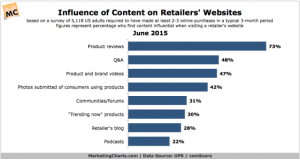While talking about marketing automation. CRMs and CDPs, don’t forget the web channel, especially as a space for experimentation.
During the past few years, after I transitioned formally and more fully to the marketing operations and technology space, I’ve continued to feel a bit of a misfit. At least through my anecdotal observations, most folks in this community have specialized in marketing automation and adjacent subspecialties, and there is nothing wrong with this. However, as a person who gained experience working mainly with content management systems (CMSs), and administering similar systems like form builders and community platforms, those are the people to whom I can more closely relate.
Recently Darrell Alfonso, a marketing operations thought leader and MarTech contributor, asked on LinkedIn what people think is the most underrated platform or system in martech. While he had a limited number of slots for a LinkedIn post-poll, he didn’t mention web systems. Although I began drafting this column before he posted that poll, I feel that the community doesn’t focus on web systems as much as it should.
While the marketing operations and technology community doesn’t ignore web systems, it could benefit from focusing on them more. Such systems aren’t just for the creative folks with copywriting, wordsmithing, and video-making skills. They are integral parts of martech stacks that, with vision, commitment and orchestration, can empower bold strategies using components throughout the stack for impactful and effective multi-channel campaigns.
Websites are far more than just places to host content, solicit personal information, and collect data. In many cases, they’re prominent parts of customer journeys. For instance, when systems like DAMs, CDPs, and DSPs are properly set up, customers can see consistent messaging and imagery across channels. When the customer is on a sporting goods e-commerce site, their site behavior can indicate their propensity to buy (specific sport or activity, cold vs. hot weather, male vs. female, apparel vs. equipment, etc.). Orchestration ensures that the online ads, the emails, paid social media posts, and the imagery and messaging they encounter during website visits and return visits, can all focus on what they expressed interest while surfing (get it?) through the site.
More control than other settings
Notably, marketing teams have far more control over setting up and presenting websites than they do over other channels. Ad networks (both digital and analog), social media networks, trade shows, and other channels place significant constraints on how organizations can present themselves.
Granted, browser and device providers, in addition to regulators, do place constraints on websites, but marketers have far more leeway than in many other channels. So, why not take advantage of this?
The power of experimentation
Insights from one channel can certainly apply to other channels. Since there is this considerable leeway in using the web channel, it makes a great place to try things out. For instance, testing – user, A/B, and multivariate – is not only an excellent way to conduct conversion rate optimization, it is a good place to test hypotheses that can help guide tactics for multiple channels.
Such hypotheses can involve messaging and imagery. Different testing tactics can help identify important insights. For instance, user testing can help marketers get into the head of customers; this tactic can include interviews and having testers speak their thoughts aloud while their sessions are recorded. While it’s impractical to conduct user testing at a large enough scale to quickly draw actionable conclusions, it can help generate experimentation ideas for A/B and multivariate tests. It is easier to present and examine how large groups react to various possibilities for content, UI elements and site flow via such tests. In turn, the data from these experiments can apply across multiple channels, not just the web.
A multi-channel view
In addition to testing, the community can consider how well the web channel can fit within multi-channel orchestration. For instance, if marketers notice that a certain audience segment responds well to some targeting, there are a variety of tactics to consider.
These can range from imagery that better reflects the segment (having people in images and videos who look like the segment members), to special deals or pricing and terms (organizational partners, public servants, and campaigns). With some orchestration using systems like analytics, CRMs, CDPs, DSPs, and DAMs, the web aspects of the customer journey can match the experience with the other channels.
Don’t forget the web
The marketing operations and technology community does an excellent job talking about marketing automation, analytics, online marketing, and CDPs. Still, there’s a lot of value in considering these channels in concert with the web channel. Marketing operations and technology span the entire customer journey, and leaving the web portions mainly to our creative colleagues doesn’t serve anyone well. And remember, our creative colleagues are valuable collaborators in our more traditional channels. So, the aim is to partner, not commandeer.
The post Marketing operations and technology shouldn’t ignore the web appeared first on MarTech.
MarTech(23)
Report Post






